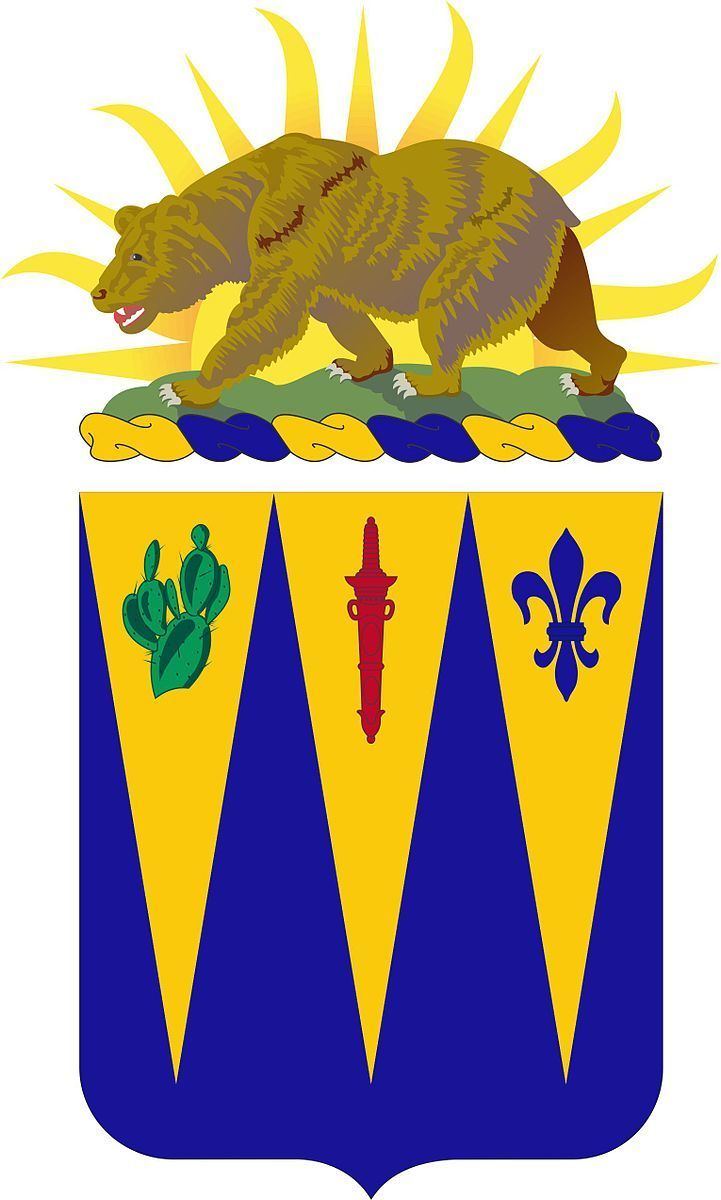Active 1917 - 2000 | Country United States Type Infantry | |
 | ||
The 159th Infantry Regiment was an infantry regiment of the United States Army. It served as a part of the 40th Infantry Division for most of its history before deploying in World War II as a part of the 7th Infantry Division.
Contents
History
The regiment traces its lineage to an infantry battalion organized in December 1879.
World War I
The 159th Infantry Regiment was first constituted and activated in the Regular Army in the 80th Infantry Brigade, 40th Infantry Division. It served with the division until 1942.
World War II
On 1 July 1940, the 7th Infantry Division was reactivated at Camp Ord, California, under the command of Major General Joseph W. Stilwell. The 7th Infantry Division was assigned to III Corps of the Fourth United States Army, and that year it was sent to Oregon for tactical maneuvers. Division units also practiced boat loading at the Monterey Wharf and amphibious assault techniques at the Salinas River in California. With the Japanese attack of Pearl Harbor, the division was sent to Camp San Luis Obispo to continue its training as a combat division. The 53rd Infantry Regiment was removed from the 7th Division and replaced with the 159th Infantry Regiment, newly deployed from the California Army National Guard.
For the early parts of the war, the division participated mainly in construction and training roles. On 9 April 1942, the division formally redesignated as the 7th Motorized Division. It began training in the Mojave Desert in preparation for deployment to the African theater. However, it was again designated the 7th Infantry Division on 1 January 1943, when the motorized equipment was removed from the unit and it became a light infantry division once more. It began rigorous amphibious assault training under Marines from the Fleet Marine Force, before being deployed to fight in the Pacific theater instead of Africa. General Holland Smith oversaw the unit's training.
Aleutian Islands
Elements of the 7th Infantry Division first saw combat in the amphibious assault on Attu Island, the western-most Japanese entrenchment in the Aleutian islands chain. Elements landed on 11 May 1943, spearheaded by the 17th Infantry Regiment, and fought an intense battle over the tundra against strong Japanese resistance. The fight for the island culminated in a battle at Chichagof Harbor, when the division destroyed all Japanese resistance on the island on 29 May, after a suicidal Japanese bayonet charge. During its first fight of the war, 600 soldiers of the division were killed, while killing 2,351 Japanese and taking 28 prisoners.
According to "Order of Battle: US Army World War II" by Shelby Stanton, the 159th was relieved from the 7th Infantry Division on 23 August 1943 and assigned to the Alaskan Department, and it departed Attu on 9 August 1944. Arriving at the Seattle Port of Embarkation eleven days later, it was transferred to Camp Swift, Texas on 28 August 1944. It moved to Camp Callan, California, on 20 December 1944 before returning to Camp Swift on 28 January 1945. The regiment staged at Camp Kilmer, New Jersey on 27 February 1945 before departing from the New York Port of Embarkation on 7 March 1945. It arrived in France eleven days later and was attached to the 106th Infantry Division. As part of the 106th, it entered Germany on 25 April 1945. On 4 November 1945 it returned to the New York Port of Embarkation and was inactivated at Camp Shanks, New York on that same date.
Post-World War II
The 159th was reactivated in the post-war years and underwent several force reorganizations, including assignment as an element of the 49th Infantry Division and 49th Infantry Brigade. From January 1974 until January 1976 its 1st Battalion was part of the 40th Infantry Division; its 2nd Battalion was part of the 40th Infantry Division from January 1974 until October 2000. It is not currently listed as an active unit of the California Army National Guard.
Distinctive unit insignia
A Gold color metal and enamel device 1 3/32 inches (2.78 cm) in height overall consisting of a shield blazoned: Azure, three piles issuant Or, in chief a prickly pear cactus Vert, a sheathed Roman sword paleways, point to base, Gules, and a fleur-de-lis of the first. * Symbolism The shield is blue for Infantry. The three piles indicate that the organization has been in Federal service three times, and each pile is charged with a device representative of the service in which the organization has been engaged – Mexican Border service, Spanish War service and service in France during World War I.
The distinctive unit insignia was approved on 20 April 1927.
